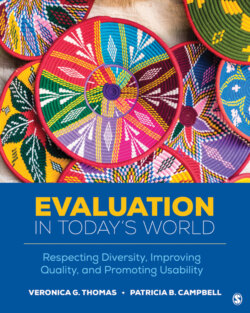Читать книгу Evaluation in Today’s World - Veronica G. Thomas - Страница 67
На сайте Литреса книга снята с продажи.
Reflect and Discuss: Evaluator Sources for Ethical Thinking
ОглавлениеConsider the five sources of ethical thinking described as follows and the examples provided. Now, provide additional examples of instances when an evaluator should avoid or rely on one or more of these sources while working in the field. Reflect on and discuss your responses with others.
Intuition: An evaluator may have an intuitive feeling that something is wrong when a program director demands a summary of an interview with a particular staff member.
Past experience: Because of a previous bad experience, the evaluator makes sure that the evaluation contract explicitly states the purpose and scope of the evaluation, who has input into the evaluation planning, expected deliverables, and how the results will be used.
Observations of or consultation with colleagues: An evaluator may observe a colleague’s use of a particular methodology when conducting focus groups with Indigenous populations that would be most responsive to use in another evaluation. In yet another instance, an evaluator might consult with trusted colleagues about an ethical dilemma in order to get the perspective of other evaluators before taking action.
Personal values and beliefs: Evaluators use their personal values, visions, and beliefs to make a decision about the right course of action to take when mistreatment of clients was observed while visiting the program site for the purpose of meeting with the program staff.
Rules and codes: Evaluators refer stakeholders to guidelines and standards provided by the AEA’s Evaluators’ Ethical Guiding Principles and the Joint Committee on Standards for Educational Evaluation’s Program Evaluation Standards to justify their behavior.
Source: Adapted and updated from Newman and Brown (1996).
Any one, or a combination, of these sources can be appropriate (or inappropriate) under certain circumstances. For example, evaluators can have “educated intuition,” making them more sensitive and alert to the nuances of potential ethical conflicts if they have thought through conflicts before either in simulations or in real life (Newman & Brown, 1996). However, overreliance on one particular source can become problematic. Evaluators who, for instance, primarily rely on intuition or past experience to guide their ethical thinking might inappropriately generalize what was seemingly ethical behavior in a previous setting to a different context that might render that behavior problematic. Evaluators who exclusively use their own personal values and beliefs to make ethical decisions may be on ethically shaky grounds, particularly when they are from the dominant group and working in a setting that primarily serves persons of color and other marginalized groups such as people with disabilities and the elderly. For example, sometimes the values, beliefs, and experiences of the dominant group are used as the yardstick, point of reference, norm, or standard by which persons from the dominant group judge the values, beliefs, and behaviors of marginalized groups. Since values and beliefs are influenced by individuals’ cultural background, the use of a dominant standard by the evaluator can be inappropriate and lead to faulty conclusions. For example, as shown in the following case study, the fact that an instrument has demonstrated validity in a dominant setting does not automatically make it ethical to use that same instrument in another setting.
